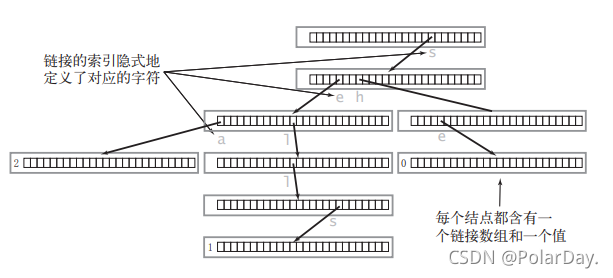点击阅读更多查看文章内容
字典树
介绍
字典树也叫前缀树、Trie树等
字典树是一颗非典型的多叉树模型
字典树的结点包含有一个长度为26的指针数组,分别对应26个字母,指向当前字母对应的下一个字母。
字典树充分利用了字符串的公共前缀
包含三个单词 “sea”,”sells”,”she” 的字典树如下所示:

图片来源
代码实现
定义
1
2
3
4
5
6
| struct Trie
{
vector<Trie *> children;
string word;
Trie() : children(26), word("") {}
};
|
插入
1
2
3
4
5
6
7
8
9
10
11
12
| void insert(Trie *root, string word)
{
Trie *node = root;
for (char c : word)
{
c -= 'a';
if (node->children[c] == nullptr)
node->children[c] = new Trie();
node = node->children[c];
}
node->word = word;
}
|
查找
1
2
3
4
5
6
7
8
9
10
11
12
13
14
15
| bool search(Trie *root, string word)
{
Trie *node = root;
for (char c : word)
{
c -= 'a';
if (node->letter[c] == nullptr)
return false;
node=node->letter[c];
}
if (node->word != "")
return true;
else
return false;
}
|
前缀查找
1
2
3
4
5
6
7
8
9
10
11
12
| bool startsWith(Trie *root,string prefix)
{
Trie *node = root;
for (char c : prefix)
{
c -= 'a';
if (node->letter[c] == nullptr)
return false;
node=node->letter[c];
}
return true;
}
|
例题
LeetCode 208
Trie(发音类似 “try”)或者说 前缀树 是一种树形数据结构,用于高效地存储和检索字符串数据集中的键。这一数据结构有相当多的应用情景,例如自动补完和拼写检查。
请你实现 Trie 类:
Trie() 初始化前缀树对象。
void insert(String word) 向前缀树中插入字符串 word 。
boolean search(String word) 如果字符串 word 在前缀树中,返回 true(即,在检索之前已经插入);否则,返回 false 。
boolean startsWith(String prefix) 如果之前已经插入的字符串 word 的前缀之一为 prefix ,返回 true ;否则,返回 false 。
1
2
3
4
5
6
7
8
9
10
11
12
13
14
15
16
17
18
19
20
21
22
23
24
25
26
27
28
29
30
31
32
33
34
35
36
37
38
39
40
41
42
43
44
45
46
47
48
49
| class Trie
{
private:
vector<Trie*> letter;
bool isend = false;
public:
Trie():letter(26), isend(false)
{
}
void insert(string word)
{
Trie *node = this;
for (char c : word)
{
c -= 'a';
if (node->letter[c] == nullptr)
node->letter[c] = new Trie();
node = node->letter[c];
}
node->isend = true;
}
bool search(string word)
{
Trie *node = this;
for (char c : word)
{
c -= 'a';
if (node->letter[c] == nullptr)
return false;
node=node->letter[c];
}
if (node->isend)
return true;
else
return false;
}
bool startsWith(string prefix)
{
Trie *node = this;
for (char c : prefix)
{
c -= 'a';
if (node->letter[c] == nullptr)
return false;
node=node->letter[c];
}
return true;
}
};
|
LeetCode 212
给定一个 m x n 二维字符网格 board 和一个单词(字符串)列表 words,找出所有同时在二维网格和字典中出现的单词。
单词必须按照字母顺序,通过 相邻的单元格 内的字母构成,其中“相邻”单元格是那些水平相邻或垂直相邻的单元格。同一个单元格内的字母在一个单词中不允许被重复使用。
示例:
输入:board = [[“o”,”a”,”a”,”n”],[“e”,”t”,”a”,”e”],[“i”,”h”,”k”,”r”],[“i”,”f”,”l”,”v”]], words = [“oath”,”pea”,”eat”,”rain”]
输出:[“eat”,”oath”]
1
2
3
4
5
6
7
8
9
10
11
12
13
14
15
16
17
18
19
20
21
22
23
24
25
26
27
28
29
30
31
32
33
34
35
36
37
38
39
40
41
42
43
44
45
46
47
48
49
50
51
52
53
54
55
56
57
58
59
60
61
62
63
64
| class Solution
{
public:
int dirs[4][2] = {{1, 0}, {-1, 0}, {0, 1}, {0, -1}};
vector<string> ret;
struct Trie
{
vector<Trie *> children;
string word;
Trie() : children(26), word("") {}
};
void insert(Trie *root, string word)
{
Trie *node = root;
for (char c : word)
{
int i = c - 'a';
if (node->children[i] == nullptr)
node->children[i] = new Trie();
node = node->children[i];
}
node->word = word;
}
void dfs(int x, int y, Trie *node, vector<vector<char>> &board)
{
char c = board[x][y];
if (node->children[c - 'a'] == nullptr)
return;
board[x][y] = '#';
node = node->children[c - 'a'];
if (node->word != "")
{
ret.push_back(node->word);
node->word="";
}
for (int i = 0; i < 4; i++)
{
int newx = x + dirs[i][0];
int newy = y + dirs[i][1];
if (newx >= 0 && newx < board.size() && newy >= 0 && newy < board[0].size())
{
if (board[newx][newy] != '#')
{
dfs(newx, newy, node, board);
}
}
}
board[x][y] = c;
}
vector<string> findWords(vector<vector<char>> &board, vector<string> &words)
{
Trie *root = new Trie();
for (string s : words)
insert(root, s);
for (int i = 0; i < board.size(); i++)
{
for (int j = 0; j < board[0].size(); j++)
{
dfs(i, j, root, board);
}
}
return ret;
}
};
|


